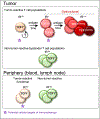Heterogeneity and fate choice: T cell exhaustion in cancer and chronic infections
- PMID: 31181510
- PMCID: PMC7608527
- DOI: 10.1016/j.coi.2019.04.014
Heterogeneity and fate choice: T cell exhaustion in cancer and chronic infections
Abstract
CD8 T cell differentiation is a tightly regulated process generating effector and memory T cells over the course of acute infections. In cancer and chronic infection, this differentiation program is derailed, and antigen-specific CD8 T cells differentiate to a hyporesponsive state generally referred to as T cell exhaustion. Here, we review recent findings on heterogeneity of tumor-specific T cells and exhausted T cells during chronic infections, discussing distinct differentiation state dynamics, fate choices, and functional states. Delineating the regulatory mechanisms defining distinct T cell states and determining the requirements for therapeutic reprogramming of these states will provide needed insights for the design of effective immunotherapies for the treatment of cancer and chronic infections.
Copyright © 2019 Elsevier Ltd. All rights reserved.
Conflict of interest statement
Conflict of interest statement
Nothing delcared.
Figures


References
-
- Wherry EJ et al.: Molecular signature of CD8+ T cell exhaustion during chronic viral infection. Immunity 2007, 27:670–684. - PubMed
Publication types
MeSH terms
Grants and funding
LinkOut - more resources
Full Text Sources
Other Literature Sources
Medical
Research Materials

